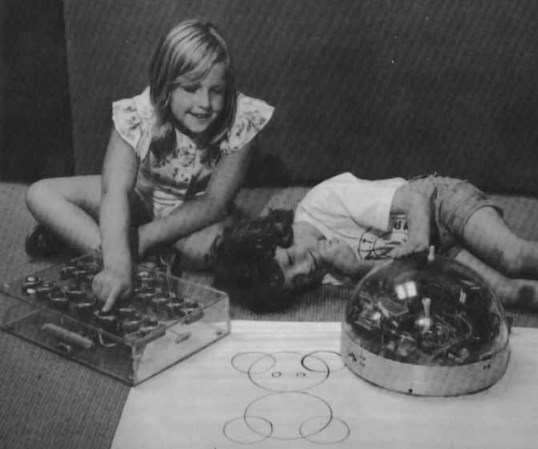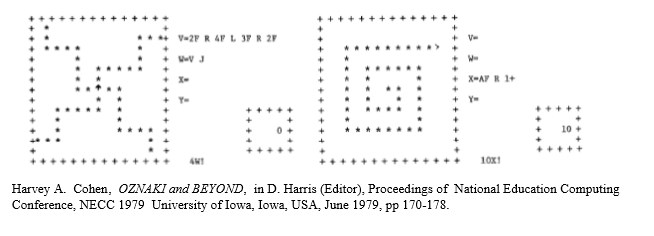Impact of Radia Perlman's TORTIS on OZNAKI
And yet substantial differences in philosophy
Very briefly the educational robotics langauage LOGO was developed by Walter Feurzig and Seymour Papert. Noteably the programming task was to direct an ambulatory robot, termed a Turtle, which had an inherent FORWARD direction, and could rotate about its axial centre.
Early implementations of the language gave it a look like the language BASIC, but recursion was a part of the system, so that the simplest code fragment - that drew an equilateral triangle , was based on this code
>TO TRI
10 FORWARD 100
20 RIGHT 120
30 TRI
Then the command
>TRI
sent the Turtle on an endless triangular path -- until stopped.
An enormous amount of ideas flowed from the simple scheme ennabling creative development of mathematics by school children.
But how might it be applied to young childen - say toddlers - aged 3 to 5?
This was brilliantly done by Radia Perlman, then an undergraduate at MIT, as part of her UROP (Undergraduate Research Opportunity) time spent under the supervision of Seymour Papert, director of the LOGO Group, within the MIT Artificial Intelligence Laboratory.
Perlman called her project, TORTIS for "Toddler's Own Recursive Turtle Interpreter System", and a photograph from that period shows her system in action:

In this delightful image the "bear" image was patently produced by the instructor, and the wide control tape is hidden behind the turtle, and by the boy's legs before it exits the field of view to the right.
In the button box shown the Forward command was given by a single key, with a sequence of commands initiated by a
F5
as the sequence for producing five forward steps.
But note well that Perlman included "Recursive" in the acronym TORTIS. This was consistent with the major philosophy within members of the MIT LOGO Group -- self-consciously parodied(*) by the in-house document, Working Paper #9, of April 1973, by an anomynous author ( "Admiral Turtle" ).[ Who was not this writer. ]
In OZNAKI the like command would be
5F
and rather than recursion, a simple accumulator with contents A introduced in screen versions, so, for instance a squiral could be drawn with repeated applications of a defined command
X = AFR +
where A increments the accumulator by 1, and the command + increments the Accumulator by 1.

In the image on the left, a simple 4-fild figure is produced by the iteration 4W, where the command W was defined using the command J, which causes the (screen) Turtle to jump home, maintaining heading. (**)
(*) e.g., Jean Piaget [with whom Papert had worked] and Inhelder wrote several books entitled The Child's Concept of . . . . including notably The Child's Concept of Space but never one with a recursive title such as The Child's Concept of Concept.
(**) In 1978 an effort was made within the MIT Logo Group to standardise LOGO, and this writer and Andrée Baulieu-Green were the minority demanding this useful basic function for Turtle graphics.